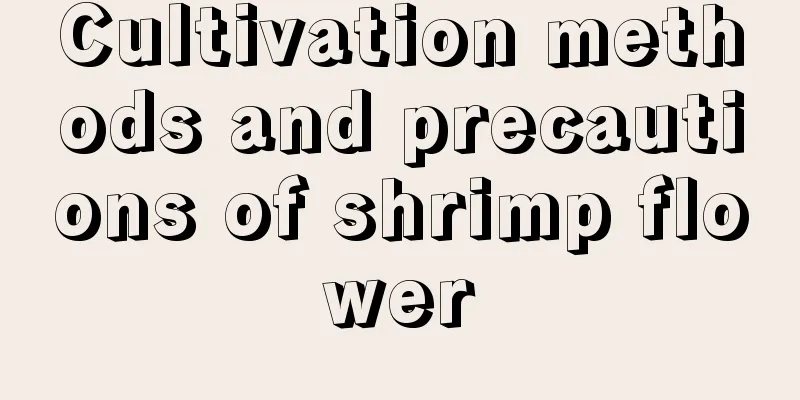Cultivation methods and precautions of shrimp flower

How to cultivate shrimp flowerTemperature and lightShrimp flower likes warmth, the minimum temperature is about 5-10℃, and the suitable growth temperature is between 18-28℃. Shrimp flower likes light and is relatively shade-tolerant. If there is insufficient light for a long time, the color of the shrimp flower bracts will become lighter, reducing its beauty and producing fewer flowers. Pay attention to proper sun protection and avoid excessive exposure in summer. The wintering temperature of shrimp flower cannot be lower than 16℃, and it must be given sufficient light. Water and fertilizerShrimp flower likes moisture, so the soil needs to be kept moist at all times. During the growth period, apply organic liquid fertilizer every 10-15 days, and increase phosphorus and potassium fertilizers reasonably. At the same time, spray potassium dihydrogen phosphate on the leaves once a week. Begin to reduce watering in mid-August. soilIt is appropriate to choose sandy loam rich in humus, which can be made by mixing equal amounts of loam, leaf mold and sand. Precautions for the cultivation of shrimp flowersDuring the growth period of the shrimp flower, it should be topped and pruned at any time to encourage more branches. In addition, some agents such as paclobutrazol or dwarfing should be sprayed appropriately to prevent excessive growth and control the internode height, which is conducive to making the plant compact and full and blooming more in autumn. After the shrimp flower withers, watering should be reduced and old branches should be cut off to encourage it to continue to sprout new branches and bloom again. The repotting of the shrimp plant is carried out in spring every year, combined with pruning, usually cutting off about 1/3. To make the plant fuller, you can pinch the top several times. Before and after the Frost Descent, the plant needs to be moved into a well-ventilated and well-lit place indoors, and the soil in the pot should be kept moist. The room temperature should not be lower than 10℃. During the growth period, scale insects and red spiders are prone to damage, so pay attention to timely prevention and control. |
<<: What are the varieties of Paulownia
Recommend
Don’t panic when succulents encounter insects. I will teach you one trick to kill all the insects!
Common scale insect Friends who grow succulents m...
How to water hydrangea in winter
Watering hydrangea in winter Hydrangeas need to b...
When is the best time to plant sunflowers?
As a cold-resistant plant, sunflowers are usually...
How to grow asparagus fern
1. Temperature The maintenance of asparagus fern ...
How to care for Strelitzia reginae in summer
Strelitzia reginae summer light requirements Comb...
Where do pineapple seeds come from?
Where do pineapple seeds come from? The reason wh...
The whole process of peach seed seedling raising method
Raising peach tree seedlings from seeds is a comm...
Disease control of sugar beet
1. Damping-off disease. The disease manifests its...
How much does it cost to plant 50 acres of lawn (investment cost and profit per acre of lawn)
The cost and prospects of planting 50 acres of la...
Picture appreciation of Yamato Brocade (Dahe Brocade)
Picture appreciation of Yamato brocade Echeveria ...
Edible value of roses
Nutritional value of roses Rose has a rich and sw...
You don’t need to buy flowers to grow. Just pick up a leaf and throw it into the soil, and 100 pots will be filled with them!
Don't buy Kalanchoe, pick up a leaf and it wi...
Are orchids easy to grow? How to grow orchids?
Orchid is one of the top ten famous flowers in Ch...
Growth environment conditions and characteristics of mosquito repellent grass
Environmental conditions and requirements for the...
Purple beans planting time and method cultivation management technical points
Purple bean planting time Purple beans are best p...









